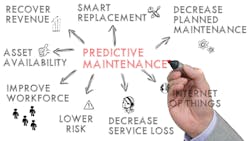Guest column: A.I. accelerates fleet predictive maintenance programs
By Jonathan Bates, head of global marketing at MiX Telematics
For fleets, predictive maintenance has been a mainstay practice, giving them the opportunity to optimize keeping vehicles on the road and to become more structured in identifying potential issues before they lead to unexpected negative outcomes.
Predictive maintenance involves leveraging historical data to predict, on the balance of statistical probability, future patterns, and then applying those patterns to suggest preemptive actions. It’s an important component of fleet maintenance, as it is using real-world data to maximum effect to plan and take action more preemptively rather than reactively.
Telematics data already plays an important role in measuring predictive maintenance by helping fleets monitor key components of vehicle performance, such as engine temperature, oil pressure, battery voltage and accelerometer data.
Looking forward, the future is connected and smart, and the smarter individual components get, the more accurate predictive analytics will be in getting it right even faster. For telematics technology, the challenge will be optimizing predictive analytics in terms of accuracy, speed, comprehensiveness of practical application, granularity and best practice sharing. As more maintenance professionals adopt this type of approach, the base data sets will become larger, and the larger the data sets, the more accurate the resulting models will be in predicting the future.
One of the biggest technology drivers for fine tuning predictive maintenance programs through telematics over the next few years—and sifting through these larger data sets—is artificial intelligence (AI).
AI algorithms highlight key trends that can be used to better inform fleet management. Typically, a dynamic dashboard is constructed that allows maintenance professionals to see, for example, vehicles with recurring issues, operations and sub-units with higher numbers of engineering-related events, and which vehicles should be prioritized for maintenance. The AI built into the dashboard can also identify which makes and models are most likely to need attention in the future.
Vehicle types can be added to dashboard watch lists, meaning that the software shows where the problem areas could be in the future without engineering teams having to review a number of reports to detect possible fleet engineering issues. These dashboards mean that maintenance professionals can optimize the use of repair time, ensure that vehicles are serviced before an event becomes a problem, and spot recurring issues across multiple vehicles of a certain type.
These AI-enabled predictive maintenance programs are not difficult to implement. Typical telematics solutions can be augmented by a predictive maintenance service – the intelligence is in the AI algorithms, therefore it’s not about fitting more physical equipment to vehicles beyond what is already in use. However, implementation must be carefully managed by a partner who knows how to help a fleet operator get up and running with predictive maintenance practices.
To do this correctly, fleet operators should adopt a phased approach to building these insights into their business practices. They should first tackle the most impactful issues prevalent in a fleet in phase one such as uncovering underlying trends that are otherwise virtually invisible that the AI model can then predict to occur fairly imminently should no action be taken.
An example of this in a business fleet would be to understand the following trends and their relationship to maintenance costs, then to incorporate into the predictive model as they will likely be the events that cause the most disruption and cost to a fleet.
- Battery voltage less than X
- Battery voltage above X
- Air pressure is less than X
- Engine coolant temp above X
- Engine oil temp above X
- Brake lining below X
Then the next phase would be more about customization – potentially some fleets will want to focus on understanding predicting behavioral patterns by vehicle type, to help inform not only maintenance but also future vehicle procurement strategy, whereas others will want to do a deep dive on the not so imminent trends by using the AI to build watch lists across the fleet. A level of flexibility is required, as every fleet has its unique nuances and situational context and the data will tell us different things dependent upon the unique characteristics of how every individual fleet is operating.
As telematics technology marches forward, AI is an exciting area for building models for predictive analytics that can process large volumes of data sets and give better insights to fleet managers on taking preemptive actions to improve vehicle utilization and reduce unnecessary maintenance costs.
